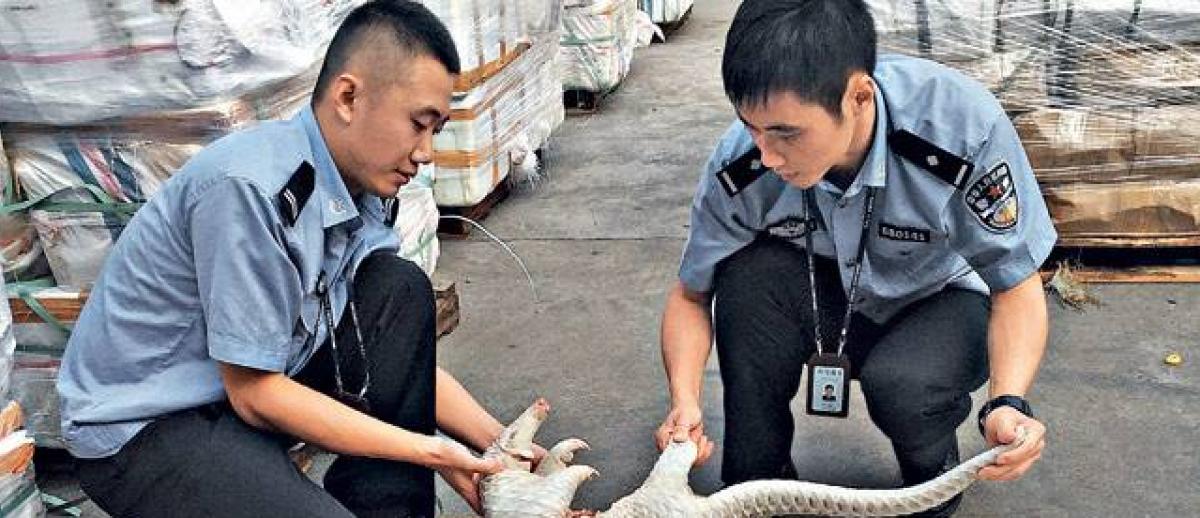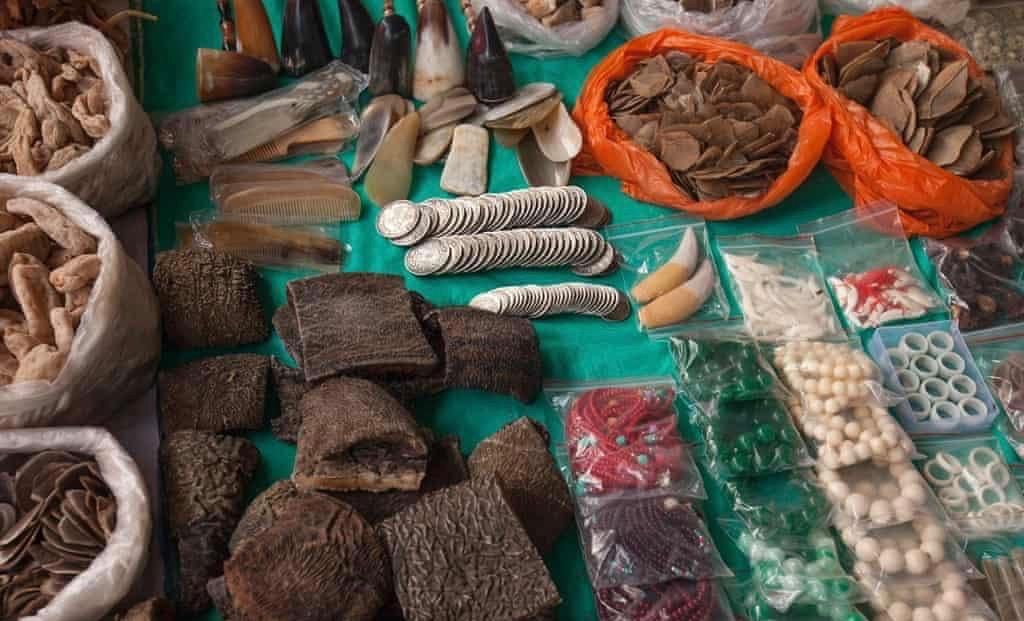On Markets and Pandemics: A View from India
archive


Chinese officials examine black market pangolin thought to have been poached in Madhya Pradesh, India, 2016. (Source: Getty Images)
On Markets and Pandemics: A View from India
Pandemics like the one caused by the novel coronavirus do not respect international borders. Viruses crisscross through national sovereignties, nationalities, and cultural ecologies and inject a new sense of forced equality and uniformity. Once again, the world becomes a global village in a real sense. Unlike global goods and services, however, for the pandemic to penetrate global societies, no multinational companies are needed, no innovations and patenting are pre-requisite and no multilateral institutions are essential to regulate it. A pandemic thus has the potential to transform an abstract global marketplace into humane societies, and competition into cooperation, without any conscious efforts and global norms. Nevertheless, the pandemic also teaches us that even very local and regional commodity markets, like the wet market in Wuhan, China, can have globally deleterious effects.
The macroeconomic impact of the coronavirus pandemic is palpably high even now and is going to disconnect, disrupt, and dislocate the entire economic system and institutions across the world. Factories, schools, hotels, offices, and other business remain partially to fully closed. Financial markets are fast sliding. The unfathomably deep global reach of China in terms of goods, services, and technology—including projects under the Belt and Road Initiative—are facing a newer variety of challenges such as disruptions to supply chains, sliding business confidence, and severe damage to China’s image as a fast-emerging global power.
The View from India
The total volume of Sino-India trade increased from a mere $3.4 million in 1970 to $ 2.8 billion in 2000 and to a whopping $90.16 billion in 2018. This was expected to reach over $100 billion by 2025. The Confederation of Indian Industry1 just published an analysis of the impact of COVID-19 on shipping, pharmaceuticals, automobiles, IT and mobiles, electronics, textiles, chemicals, solar power, tourism, and aviation. It found that China accounts for 45 percent of India’s total electronics imports, 33 percent of machinery, 40 percent of organic chemicals, 25 percent of automotive parts and fertilizers, almost 90 percent of certain mobile phone parts, and close to 100 percent for many critical antibiotics and antipyretics.
The CII report also reveals that 72 percent of China-based Indian companies related to industrial manufacturing and services, IT & BPO, logistics, chemicals, airlines, and tourism are situated in eastern cities like Shanghai and Beijing, and in the provinces of Guangdong, Jiangsu, and Shandong. An emerging confidence deficit was highlighted by the report’s conclusion that “the biggest challenge for Indian industry operating in China will be retaining and recruiting talent, as most of the persons will now prefer to work near their home.”
There has furthermore been a sharp drop in the dry bulk cargo movement as Indian ships cannot enter into Chinese ports. As a result, volume per day per vessel has declined by more than 75-80 percent in dry bulk trade. If the shutdown in China persists it could result in an 8-10 percent contraction of Indian auto manufacturing in 2020. It could slow down cotton yarn exports by 50 percent, leading to a severe impact on the spinning mills in India. Some 48 cities and four provinces in China are literally in lockdown mode, affecting many aspects of Indian society. For example, provinces like Jiangsu, Guangdong, Anhui, and Zhejiang are major suppliers of solar equipment. The mobile phone industry is badly affected as India has started running out of stocks of components. Smartphone sales may fall 10-15 percent in the January to March quarter and fall much sharper in the April-June period. Over 281,000 Chinese tourists visited India in 2018; had it not been for the pandemic, the number was projected to reach 500,000 in 2020. As the number of countries affected by this pandemic increases, it is bound to affect India’s business and other commercial engagements with these countries, implying a protracted and unprecedented situation of economic slowdown.
Around 70 percent of active pharmaceutical ingredients (worth $2.4 billion) that go into India’s manufacture of widely-used medicines like paracetamol, metformin, ofloxacin, metronidazole, ampicillin, and amoxicillin are imported from China. There has already been a tangible markup in prices of many of these medicines.2
Besides the toll in human lives, every pandemic has other devastating economic impacts and deleterious social consequences. Depending on where the epicenter of any pandemic is located, countries and people across the globe condemn the nation of origin, throw utterly disgusting racial slurs and, more seriously, resort to condemnable propaganda. Epidemics and pandemics regularly engender largely inhumane hegemonic discourse and finger-pointing. The racial overtones are regularly seen in airports, public transportation, parks, and malls and of course all versions of social media.
Around 70 percent of active pharmaceutical ingredients that go into India’s manufacture of widely-used medicines like paracetamol, metformin, ofloxacin, metronidazole, ampicillin, and amoxicillin are imported from China.
Health crises also provide huge economic space for negative stakeholders: shortages of key supplies prompt hoarding, black markets, and price gouging, as the horrific price hikes of medicines, hand sanitizer, masks, and paper napkins demonstrate. These practices are just the tip of the iceberg. Moreover, as is becoming clear all over again, opportunistic stakeholders, fly-by-night operators, and pariah entrepreneurs may even create the conditions for epidemics to spread beyond local origins.
The Exotic Wildlife Market
It is widely believed that COVID-19 originated in the wet markets in Wuhan in China. Earlier in November 2002, the epicenter of the severe acute respiratory syndrome (SARS) epidemic was Foshan municipality in Guangdong province of China. While studying epidemiologic clues to SARS, Rui-Heng Xu et al. examined seven severely infected patients and found that “Patient 4 worked as a chef in a Zhongshan township restaurant, where he prepared steamed dishes and had contact with snakes, civet cats, foxes, and rats. He infected his 30-year-old wife, a 39-year-old male friend who visited him in hospital and a 35-year-old male physician” as well as at least three healthcare workers.
China remains the most coveted destination for the overwhelmingly illegal wildlife market. Scores of both licensed and illegal commercial breeding centers supply tigers, porcupines, pangolins, bears, snakes and rats. A study by the Chinese Academy of Engineering stated that, in 2016, there were more than 14 million people working in the wildlife-related industry that fetched $74 billion. The menu of deep-fried bats, boiled snakes, shark fin soup, pangolin stews, sweet and sour salamander, and hotpot of frogs become the most sought after and relishing exotic food available for so-called “Asian Super Consumers.” For example, a report by the wildlife conservation organization TRAFFIC found that China’s small Macau region alone imported around $97 million worth of wildlife commodities per year from 2005 to 2016, and around 100 tons of shark fins annually from 2012 to 2017, making it the third largest importer of shark fins in the world.
A visit to this wet market presents the most torturous and frightening sight of unhygienic and contaminated spaces, cramped animal cages, unregulated abattoirs, and sales of smuggled and sick wild animals. In this surreptitiously built market, a complex virus homology exists where the spillover of animal contagions to humans actually happens. As in the case of bats with Ebola and pigs with SARS, this time the virus strains of pangolins matched3 to a certainty of 99 percent with the one causing Covid-19.

Illegal wildlife products for sale at a covered market in MongLa, Myanmar, on the Chinese border. (Source: The Guardian/Alex Hofford)
Through poaching and piracy, the Himalayas have lost without trace some magnificently beautiful creatures like porcupine, pangolin, flying squirrel, snake, toad, fox, salamander, varieties of birds, insects, and butterflies, snow leopard, musk deer, and scores of rare mammal and amphibians along with diverse flora. Another TRAFFIC report entitled ‘Assessment of Illegal Trade-Related Threats to Red Panda’ (2020) revealed significant incidences of crimes in Nepal on their endangered population of 14-15,000 in the eastern and north-eastern Himalayan subalpine regions.
Could COVID-19 then be angrily triggering a ‘natural selection’ warning bell to those who dislocated the entire prey and predator relationship and disrupted the ecosystem? The wildlife community that was in existence much earlier than, and later evolved, nurtured, and coexisted alongside human beings, has suddenly become a central focus as some species now carry zoonotic diseases that transmit to people, causing pandemics.
A study by the Chinese Academy of Engineering stated that, in 2016, there were more than 14 million people working in the wildlife-related industry that fetched $74 billion.
Acknowledging Wuhan’s illicit wildlife connection, China's apex law-making body, the Standing Committee of the National People’s Congress of the Communist Party of China, has now banned wildlife trade. China is a signatory to the Convention on International Trade in Endangered Species of Wild Fauna and Flora (CITES),4 and has imposed wildlife crime penalties of $29,441 (RMB 0.20 million) and life imprisonment. However, wildlife trade continues unabated, and the use of more sophisticated e-commerce platforms with highly coded messaging keeps vigilance at bay.
Powerful syndicates
The interest groups that thrive on animal trafficking—globally interconnected, patronized by powerful syndicates with broad reach into crime, conflict, and terrorism—are so deeply entrenched that closing down the licensed breeding farms and putting the smugglers in permanent quarantine is never going to be effective. Given US President Trump’s parochial obsession to call COVID-19 a “Chinese virus,” China once again faces a threefold challenge to minimize the damage to its image and the adverse impact on its relations with the global community brought about by the pandemic.
First, China must place its domestic demand side on a war footing, permanently and heavily clamping down on the demand for wildlife-based exotic delicacies, trophies, trinkets, leather products, and pharmaceuticals. Second, it must enact comprehensive legislation so that wildlife traders, supply chain managers, and global storehouses are treated akin to global terrorism actors, booked and dealt severely with when caught. And third, it must make its wildlife markets and associated business actors open to the regulatory supervision of globally accepted international institutions, and allow initiatives like Coalition to End Wildlife Trafficking Online to effectively work with Chinese technology firms Baidu, Alibaba, and Tencent. China must realize that its status as a global actor has now become inextricably intertwined with local culinary and commercial practices in the wet markets of many of its cities.
1. See: https://www.cii.in/publications.aspx
2. In India’s $39 billion pharmaceutical industry, a number of pharmaceutical companies including Sun, Lupin, Glenmark, Dr Reddy’s, Torrent, and Aurobindo are already facing the brunt of diminishing supplies of needed chemicals.
3. See: https://www.traffic.org/news/pangolins-identified-as-potential-intermediate-host-of-novel-coronavirus/
4. See: https://cites.org/eng/news/SG/2011/20110408_SG_remarks_China_30th.php



